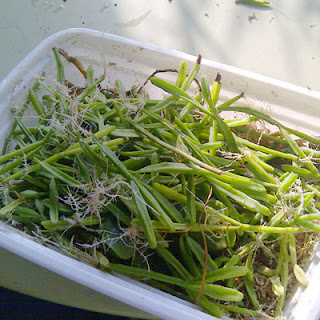i'm very pleased to share this post with steve asbell
of one of my very favourite blogs, the rainforest garden.
first up, i'll walk you through making living curtain
& then steve will explain how to make his gorgeous rainforest drops
living curtain
since my recent move to thailand, i've fallen in love with the hanging gardens that seem to be spilling from over every surface. this hanging garden will allow air to flow through my windows while providing some privacy & shade once it fills in.
materials:
- a plant - i'm using a parasitic orchid, but you can use air plants or even use this same method to wrap a regular pot for any plant.
- wood - i'm using coconut husks
- string - i'm using twine, but you can use wire as well
- a place to hang your curtain - since i live in the tropics, i'm attaching mine to the outside of my window, but you can use a curtain rod indoors if you like
- i found it was best to use plants with falling foliage near the top & rising near the bottom
- for a more layered affect, in addition to orchids, i've also added philodendron, african violets, & a blue morning glory vine. this means that in a few months, the window will be covered in blooms.
rainforest drops
I think that I've finally perfected the recipe and I couldn't wait to share. The old way works just fine, but I think that you'll find these instructions a bit easier to swallow. To sum it up: I root the cuttings first, stuff the grapevine ball with long grain sphagnum moss, and tuck in the cuttings!
This version is loads easier.
1. Pre-root the Rhipsalis Cuttings
Giving the rhipsalis cuttings a head start makes it much easier to establish your Rainforest Drop. Simply line a used and washed Chinese food takeout tray with moistened short grain sphagnum moss or potting soil, lay the cuttings down lengthwise and cover. A few weeks will do the trick.
Don't have a Chinese takeout tray? Try these instructions instead.
2. Stuff Ball With Sphagnum Moss
The long grain sphagnum moss is not only a dream to work with, but it's also very moisture retentive. This means less watering! The orchid bark from my original directions is attractive enough but has the unfortunate habit of falling through the openings in the ball and making things difficult for you.
3. Insert Rooted Cuttings
Tuck in the rooted ends of the rhipsalis cuttings and tightly pack in some more of the moistened long grain sphagnum moss around the stems. Thoroughly water your horticultural masterpiece once or twice a week, periodically mist with a spray bottle, and fertilize when the stems lose their deep green coloration.
For more information on caring for and displaying your little hanging garden, or if you want to skip the fuss and buy one from me instead, check out the Frequently Asked Questions or the original instructions ... or just drop me a line at steve_asbell@yahoo.com!










